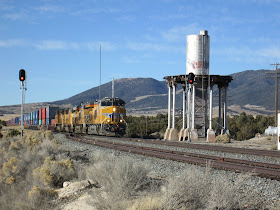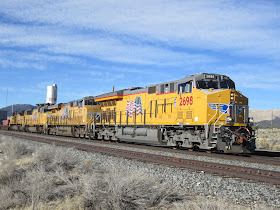The snow got thicker than I expected and set the mood for the day pretty quick... Dramatic, cold, and hard to get good pictures in. But dang the atmosphere was awesome! The train pictured here was the second grain shuttle I had seen that day passing through CP 784.
Sometime nearly a year ago I made a joke in a Facebook discussion, that the decision to railfan in the snow is comparable to the scene in
Star Wars: The Empire Strikes Back when Luke Skywalker is crawling in the snow; only for the ghost of Obi-Wan Kenobi to appear to him ordering him to seek out Yoda. I joked that in a way railfans have their "Obi-Wan" calling them into the snow despite their better judgement. On November, 28th; I had an "Obi-Wan" calling me to go snow railfanning when I got the news that Union Pacific's Denver & Rio Grande Western Heritage Unit (number 1989) was coming through Salt Lake City that day on the KOASCX-17. I couldn't resist, and had to get out trackside to catch the unit.
I have seen UP 1989 multiple times before; the first time being nearly five years ago on a train being held on the track behind the bowling alley in my hometown in Tooele, Utah. However, knowing many people online who miss the old Rio Grande; I had a newfound desire to see the locomotive again.
The yard switchers working the southern end of North Yard today were a SD40N and a GP15.
I decided to hunt for UP 1989 around CP 784, a control point at the southern end of Salt Lake City's North Yard. My first catches of the day was the familiar sight of the remote controlled yard switchers at work on the yard lead. UP 1956 was on point of the yard switcher, with its roof mounted strobe lights blinking to indicate remote controlled service. Behind it was the smaller UPY 582, a venerable GP15 which had once served the Missouri Pacific Railroad. The ex-MP GP's are still used as road switchers in the prairie country UP serves back east, but their small size and lack of dynamic brake units makes them ill suited to road work in Utah. As such in Utah they are confined to switching duties in the yards in Ogden, Provo, and Salt Lake. The growl of the EMD engines from the yard switchers made the area around CP 784 resonate with sound.

I also encountered a four legged friend at CP 784. The dog was a bit goofy, chasing my car and running into the railroad tracks. Fortunately he wasn't hurt, although he ran behind my car a few times while I was backing it up! He perhaps had better sense than I, and was gone when the snowflakes began to fall again.
One of the great things about railfanning Downtown Salt Lake City is the constant parade of Frontrunner trains. North Temple Station sees two Frontrunner trains meet each other every hour. Getting to see these trains plow through the snow reminded me of a Trains Magazine article from earlier this year which stated, "UTA has created a modern, comfortable, six-day-a-week operation in an area of the country that experiences snowy, below-zero winters and hot, dry 100-plus-degree summers. (David Lusting, Trains Magazine, July, 2016.) It wasn't yet "below-zero" today, but the air was hovering at freezing and the snow flurries made it clear that winter's onslaught was upon us.

My first through-freight train catch of the day was a stack train being lead by four SD70M units (I suspect it was the KG3LB). The SD70M's are one of the most common units on the UP, but catching an entire train being powered by just SD70M units is an increasingly rare sight. From conversations I have had with railroad employees, it seems the older DC traction units used on SD70M's don't make them quite as popular among train crews as the AC traction models which were released later. With that said, the SD70M is growing to become a railfan favorite engine, an opinion which is furthered thanks to the engine's unique production features. For example the train in the photo includes different production series of the SD70M from an earlier flat radiator model, to three flared radiators, and one cab with slights indents in the nose which was a harbinger of the future cab on the SD70ACe model.
UTAH 2006 and UTAH 2003 were on point on the Utah Railway train. Both engines are ex-SP units.
A few Frontrunner trains passed through after the stack train; and the snow began to fall at a furious rate. It was in this mini-blizzard like storm that a Utah Railway train began to peak through the fog and pull up alongside CP 784. The train pulled to a stop on Main 2, preparing to back up along Grant Tower so it could interchange freight cars (box cars, hoppers, and low-level radioactive waste) with the Salt Lake Garfield & Western shortline railroad.
When the Utah Railway train came to a halt I was surprised by the attire the conductor was wearing when he left the cab! While the safety vest was nothing out of the ordinary, his festive Christmas hat instantly caught my eye. With heavy snow blanketing the area, it was easy to imagine that it was Santa Claus himself, conducting a train loaded full of goodies (and radioactive waste too!). It seemed as if this conductor had decided to make the best of a snowy day at work, by dressing the part!
Even in the snow, the fresh paint on UP 7719 is instantly noticeable!
After the Utah Railway train had backed down Grant Tower I saw the headlights of an incoming UP train. Was it UP 1989 after all my time waiting for her? No, to my surprise it was a unit train of grain hoppers being lead by UP 7719, aa AC45CCTE sporting a fresh paint job. The grain train rumbled slowly through CP 784, and I began to get anxious waiting for the eventual arrival of UP 1989. The storm kept getting thicker, only taking brief rests before kicking up again with even more snow!
The snow stopped for a brief moment just as the Utah Railway train returned to CP 784. Having dropped most of its cargo off at the SLG&W interchange, the train was now carrying a short string of tank cars bound for the oil refineries north of Salt Lake City.
I was getting cold, and decided I needed to take a break from the tracks for a moment. I had gotten word that UP 1989 was still waiting for a crew change up in Ogden, so I made the quick drive to North Temple to pick up a hamburger! Railfanning in cold weather is actually a bit of a tricky challenge, and requires taking shelter in car and buildings to keep warm. My shoes weren't up to the task, and snow was melting into my socks.
Shortly after I began eating my burger the snow began to fall again in earnest. The fog seemed to creep further in and blocked visibility. Headlights of trains were visible long before the train itself, and when I saw another set of headlights approaching on Main 1, I was hoping that UP 1989 had finally arrived! Instead it turned out to be UP 8194 heading the second grain train I had seen that day. The numberboards were lit up making the train even more visible in the soupy fog.


A few more Frontrunner train whizzed by before I finally saw the familiar gray nose of UP 1989 pull into North Yard. The train was covered by clumps of snow, and the gray paint seemed to blend with the fog. I can see why the actual Rio Grande painted the noses of their units in a black and orange "zebra stripe" scheme; which surely would have been easier seen in a snow storm than UP 1989's gray hood! The locomotive stopped its train just short of the leaving the yard, and I would later learn that it was delayed here to wait for a train up ahead at the Salt Lake Intermodal Yard to clear the offloading area. I sat for 30 minutes or so waiting for UP 1989 to began the last leg of its journey. Finally a little bit before 4:40 pm, I saw the headlights of the engine brighten to cut their way through the fog as the train began to lurch forward.



I tried to frame UP 1989's train underneath the signal bridge at CP 784 in a sort of recreation of a
similar shot I had taken of Heber Valley's 1813 earlier this year (both engines are painted in a faux-Rio Grande inspired paint so it seemed appropriate!) The train crawled along Main 2 gaining speed as it rolled down to the Salt Lake Intermodal Yard. The golden orange sides of the locomotive were far more easier to spot in the snow than its gray nose, and seeing the Rio Grande flying letters conjured up images of yester-year when SD40T-2's battled their way across snowcapped peaks in Colorado and Utah. Of course with UP 1989 rolling out of sight I quickly jumped back into my car. I wasn't going to stay in that cold any longer! :)

Railfanning in cold weather certainly has its challenges and issues, but it also offers an amazing glimpse of railroads at work during even the harshest conditions. Even if my toes get a little cold, and my hands and face turn a bit red in the chill air; I always have fun railfanning in the snow! The sight of snow falling on the ground is one of the most stunning visuals of the intermountain west, signalling with it a change in seasons. Railroads are affected by snowfall, and watching them work in it is one of the most amazing ways to railfan.
Hasta Luego
-Jacob Lyman
Dedicated in memory of my Grandfather Rodney Lyman (March 26, 1937-December 12, 2016) who was with me and my father nearly five years ago the first time I saw UP 1989 in Tooele, Utah; parked behind the local bowling alley.





























































